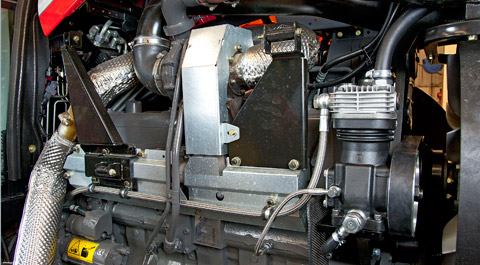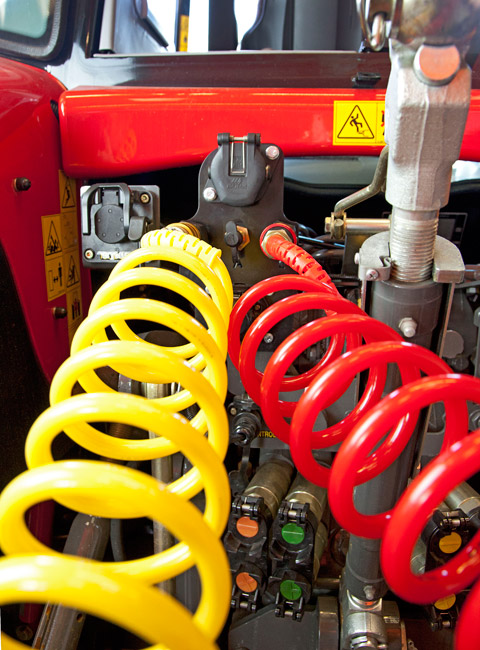Video: Fitting tractor air brakes

Plumbing up a trailer with air-brakes might be almost as simple as tying your laces, but it’s a different story with tractor pneumatics.
While the system itself is beautifully straightforward in principle – a pump, pipework and a couple of valves – installation and set-up are tricky tasks and have to be left to trained dealer staff. In fact, because fitting involves meddling with the engine oil-feed and the main brake circuits, some manufacturers say retro-fitting will invalidate any warranty unless carried out by one of their own fitters.
So, unfortunately, kits aren’t available for farm fitting.
The set-up involves just one air circuit with a compressor up at the front of the tractor filling a tank somewhere under the steps and a trailer control valve then pumping it out the back as required.
1. As the beating heart of the system, the compressor generally bolts on to the front end of the engine block and runs off the same belt that powers the air-con, alternator, water pump and fan.
Obviously, a slightly longer belt is required but the tricky bit is supplying the unit with a source of lubricant. Typically this involves tapping into the pressurised oil gallery that encloses the camshaft and then plumbing a return back into the block somewhere closer to the sump. To keep everything clean, the intake draws directly from the tractor’s main air filter.

The compressor is mounted on the side of the engine block and takes its drive from an elongated fan belt.
2. The pressurised air then runs to a reservoir, usually positioned under the cab or wheel-arches. As well as having drain down valves that must be emptied every day (unless an auto tank drain is fitted), the tank also has a blow-off valve (sometimes known as a pressure-relief or unloading valve).
That’s the thing that lets off an unexpected hiss every few minutes, just when you – or passing equestrians – are least expecting it. To show what’s going on down there, up in the cab there is a pressure gauge to show just how much air is in the tank.

The blow-off valve sits alongside the main tank under the right-hand steps.
3. The brain of the system lies in the trailer control valve. This takes a signal from the tractor’s own hydraulic brake circuit and converts it into an air signal, which travels out to the trailer along the yellow line.
The pressure in the line is proportional to the amount of force being applied to the brake pedal – stamp on it and it’ll pull the trailer up sharpish, feather it and you’ll glide to a gentle halt.
The valve also senses when the handbrake is applied and prompts the trailer brakes to come on simultaneously. But valve choice isn’t straightforward and is very specific to individual tractor models. While some brake circuits use standard DOT4 brake fluid, others employ mineral oil. Of course, they all run at very different pressures too.
4. Around at the back of the tractor are two couplings – red and yellow. The red line is fed directly from the reservoir and is constantly pressurised.
This runs directly to the trailer tank. The yellow line provides the signal to the trailer control valve as to how much braking force is required, ie how quickly the anchors need to come on.

Curly-wurly suzy-coils connect to the tractor – red provides full pressure air to keep the trailer tank topped up while the yellow line provides a signal to the trailer valve to tell it how wide to open and consequently how swiftly the trailer will anchor up.
While there aren’t too many choices when it comes to selecting the system for your tractor, there is the option of an air dryer which keeps what’s running through the circuit moisture-free – this should help to avoid any issues. Most problems with air-braking systems are down to moisture build-up in the various valves, etc…

The other option on the extras list is a clever pre-charge system that TractAir has developed. This senses the moment the driver hovers his foot on the brakes (through the brake-light switch circuit) and puts just enough air into the trailer circuit to take up any slack in the rams, actuators, levers and shoes. This means that the instant true pressure is applied to the pedal, the brakes come on without delay.
For the princely sum of £20, this cigar-shaped drain-valve continuously siphons moisture out of the tank, replacing the manual push-in version that needs attention every day.


